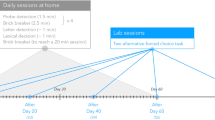Abstract
We collected subjective frequency, age-of-acquisition, and imageability norms for 319 acronyms from French adults. Objective printed frequency, bigram frequency, and lengths in letters, phonemes, and syllables, as well as orthographic neighbors, were computed. The time taken to read acronyms aloud was also recorded. Correlational analyses indicated that the relations between the psycholinguistic variables were similar to those usually found for common words (e.g., highly imageable acronyms were more frequent and learned earlier in life than less imageable acronyms), but were generally weaker in the former than in the latter. Linear mixed-model analyses performed on the reading latencies revealed that the main determinants were the voicing feature of initial phonemes, the type of pronunciation of the acronyms (ambiguous vs. unambiguous, typical vs. atypical characteristics), length (number of letters and number of syllables), together with bigram frequency, printed frequency, and imageability. Both objective frequency and imageability interacted reliably with the ambiguous typical and ambiguous atypical properties. Accuracy was predicted by the number of letters and by imageability factors: More errors occurred on longer than on shorter acronyms, and also more errors on less imageable than on more imageable acronyms. The theoretical and methodological implications of the findings for the understanding of acronym reading are discussed. The entire set of norms and the acronym reading times (and accuracy scores), together with the acronym definitions, are provided as supplemental materials.


Similar content being viewed by others
Notes
We thank an anonymous reviewer for pointing this out to us.
The same results were found when the quadratic term of imageability was removed from the equation.
It is worthy of note, however, that the correlations are dependent on the types of words used in the corpora (e.g., monosyllabic vs. dissyllabic, or nouns only vs. nouns plus other grammatical categories).
References
Balota, D. A., Cortese, M. J., Sergent-Marshall, S., Spieler, D. H., & Yap, M. J. (2004). Visual word recognition of single-syllable words. Journal of Experimental Psychology: General, 133, 283–316. doi:10.1037/0096-3445.133.2.283
Balota, D. A., Yap, M. J., Cortese, M. J., Hutchison, K. A., Kessler, B., Loftus, B., & Treiman, R. (2007). The english lexicon project. Behavior Research Methods, 39, 445–459. doi:10.3758/BF03193014
Balota, D. A., Yap, M. J., Hutchison, K. A., & Cortese, M. J. (2013). Megastudies: What do millions (or so) of trials tell us about lexical processing? In J. S. Adelman (Ed.), Visual word recognition (Models and methods, orthography and phonology, Vol. 1, pp. 90–115). New York, NY: Psychology Press.
Berry, W. D., & Feldman, S. (1985). Multiple regression in practice. Beverly Hills, CA: Sage.
Bonin, P., Barry, C., Méot, A., & Chalard, M. (2004). The influence of age of acquisition in word reading and other tasks: A never ending story? Journal of Memory and Language, 50, 456–476. doi:10.1016/j.jml.2004.02.001
Bonin, P., Méot, A., Ferrand, L., & Roux, S. (2011). L’imageabilité: Normes et relation avec d’autres variables psycholinguistiques [Imageability: Norms and relationship with other psycholinguistic variables]. L'Année Psychologique, 111, 329–359.
Brysbaert, M., & Cortese, M. J. (2011). Do the effects of subjective frequency and age of acquisition survive better word frequency norms? Quarterly Journal of Experimental Psychology, 64, 545–559. doi:10.1080/17470218.2010.503374
Brysbaert, M., & New, B. (2009). Moving beyond Kučera and Francis: A critical evaluation of current word frequency norms and the introduction of a new and improved word frequency measure for American English. Behavior Research Methods, 41, 977–990. doi:10.3758/BRM.41.4.977
Brysbaert, M., Speybroeck, S., & Vanderelst, D. (2009). Is there room for the BBC in the mental lexicon? On the recognition of acronyms. Quarterly Journal of Experimental Psychology, 62, 1832–1842. doi:10.1080/17470210802585471
Cohen, J., MacWhinney, B., Flatt, M., & Provost, J. (1993). PsyScope: An interactive graphic system for designing and controlling experiments in the psychology laboratory using Macintosh computers. Behavior Research Methods, Instruments, & Computers, 25, 257–271. doi:10.3758/BF03204507
Coltheart, M., Rastle, K., Perry, C., Langdon, R., & Ziegler, J. (2001). DRC: A dual route cascaded model of visual word recognition and reading aloud. Psychological Review, 108, 204–256. doi:10.1037/0033-295X.108.1.204
Cortese, M. J., & Fugett, A. (2004). Imageability ratings for 3,000 monosyllabic words. Behavior Methods and Research, Instrumentation, & Computers, 36, 384–387. doi:10.3758/BF03195585
Cortese, M. J., & Khanna, M. M. (2007). Age of acquisition predicts naming and lexical-decision performance above and beyond 22 other predictor variables: An analysis of 2,342 words. Quarterly Journal of Experimental Psychology, 60, 1072–1082. doi:10.1080/17470210701315467
Cortese, M. J., & Schock, J. (2012). Imageability and age of acquisition effects in disyllabic word recognition. Quarterly Journal of Experimental Psychology, 66, 946–972. doi:10.1080/17470218.2012.722660
Cortese, M. J., & Simpson, G. B. (2000). Regularity effects in word naming: What are they? Memory & Cognition, 28, 1269–1276. doi:10.3758/BF03211827
Cortese, M. J., Simpson, G. B., & Woolsey, S. (1997). The effects of association and imageability on phonological mapping. Psychonomic Bulletin & Review, 4, 226–231. doi:10.3758/BF03209397
Desrochers, A., & Thompson, G. L. (2009). Subjective frequency and imageability ratings for 3,600 French nouns. Behavior Research Methods, 41, 546–557. doi:10.3758/BRM.41.2.546
Ellis, A. W., & Lambon Ralph, M. A. (2000). Age of acquisition effects in adult lexical processing reflect loss of plasticity in maturing systems: Insights from connectionist networks. Journal of Experimental Psychology: Learning, Memory, and Cognition, 26, 1103–1123. doi:10.1037/0278-7393.26.5.1103
Evans, G. A. L., Lambon Ralph, M. A., & Woollams, A. M. (2012). What’s in a word? A parametric study of semantic influences on visual word recognition. Psychonomic Bulletin & Review, 19, 325–331. doi:10.3758/s13423-011-0213-7
Ferrand, L., Bonin, P., Méot, A., Augustinova, M., New, B., Pallier, C., & Brysbaert, M. (2008). Age of acquisition and subjective frequency estimates for all generally known monosyllabic French words and their relation with other psycholinguistic variables. Behavior Research Methods, 40, 1049–1054. doi:10.3758/BRM.40.4.1049
Ferrand, L., Brysbaert, M., Keuleers, E., New, B., Bonin, P., Méot, A., & Pallier, C. (2011). Comparing word processing times in naming, lexical decision, and progressive demasking: Evidence from Chronolex. Frontiers in Psychology, 2, 306. doi:10.3389/fpsyg.2011.00306
Ferrand, L., & New, B. (2003). Syllabic length effects in visual word recognition and naming. Acta Psychologica, 113, 167–183. doi:10.1016/S0001-6918(03)00031-3
Ferrand, L., New, B., Brysbaert, M., Keuleers, E., Bonin, P., Méot, A., & Pallier, C. (2010). The French Lexicon Project: Lexical decision data for 38,840 French words and 38,840 pseudowords. Behavior Research Methods, 42, 488–496. doi:10.3758/BRM.42.2.488
Forster, K. I. (2000). The potential for experimenter bias effects in word recognition experiments. Memory & Cognition, 28, 1109–1115. doi:10.3758/BF03211812
Gerhand, S., & Barry, C. (1998). Word frequency effects in oral reading are not merely age-of-acquisition effects in disguise. Journal of Experimental Psychology: Learning, Memory, and Cognition, 24, 267–283. doi:10.1037/0278-7393.24.2.267
Gerhand, S., & Barry, C. (1999). Age-of-acquisition and frequency effects in speeded word naming. Cognition, 73, B27–B36.
Izura, C., & Playfoot, D. (2012). A normative study of acronyms and acronym naming. Behavior Research Methods, 44, 862–889. doi:10.3758/s13428-011-0175-8
Johnston, R. A., & Barry, C. (2005). Age of acquisition effects in the semantic processing of pictures. Memory & Cognition, 33, 905–912. doi:10.3758/BF03193084
Johnston, R. A., & Barry, C. (2006). Age of acquisition and lexical processing. Visual Cognition, 13, 789–845. doi:10.1080/13506280544000066
Juhasz, B. J., & Yap, M. J. (2013). Sensory experience ratings for over 5,000 mono- and disyllabic words. Behavior Research Methods, 45, 160–168. doi:10.3758/s13428-012-0242-9
Juhasz, B. J., Yap, M. J., Dicke, J., Taylor, S. C., & Gullick, M. M. (2011). Tangible words are recognized faster: The grounding of meaning in sensory and perceptual systems. Quarterly Journal of Experimental Psychology, 64, 1683–1691. doi:10.1080/17470218.2011.605150
Keuleers, E., Lacey, P., Rastle, K., & Brysbaert, M. (2012). The British Lexicon Project: Lexical decision data for 28,730 monosyllabic and disyllabic English words. Behavior Research Methods, 44, 287–304. doi:10.3758/s13428-011-0118-4
Kuperman, V., Stadthagen-Gonzalez, H., & Brysbaert, M. (2012). Age-of-acquisition ratings for 30,000 English words. Behavior Research Methods, 44, 978–990. doi:10.3758/s13428-012-0210-4
Laszlo, S., & Federmeier, K. D. (2007a). The acronym superiority effect. Psychonomic Bulletin & Review, 14, 1158–1163.
Laszlo, S., & Federmeier, K. D. (2007b). Better the DVL you know: Acronyms reveal the contribution of familiarity to single-word reading. Psychological Science, 18, 122–126. doi:10.1111/j.1467-9280.2007.01859.x
Levelt, W. J. M., Roelofs, A., & Meyer, A. S. (1999). A theory of lexical access in speech production. Behavioral and Brain Sciences, 22, 1–38. disc. 38–75.
Mathey, S. (2001). L’influence du voisinage orthographique lors de la reconnaissance des mots écrits [The influence of orthographic neighborhood on visual word recognition]. Canadian Review of Experimental Psychology, 55, 1–23.
Mermillod, M., Bonin, P., Méot, A., Ferrand, L., & Paindavoine, M. (2012). Computational evidence that frequency trajectory theory does not oppose but emerges from age-of-acquisition theory. Cognitive Science, 36, 1499–1531. doi:10.1111/j.1551-6709.2012.01266.x
Monaghan, J., & Ellis, A. W. (2002). What exactly interacts with spelling–sound consistency in word naming? Journal of Experimental Psychology: Learning, Memory, and Cognition, 28, 183–206. doi:10.1037/0278-7393.28.1.183
Murray, W. S., & Forster, K. I. (2004). Serial mechanisms in lexical access: The rank hypothesis. Psychological Review, 111, 721–756. doi:10.1037/0033-295X.111.3.721
New, B., Ferrand, L., Pallier, C., & Brysbaert, M. (2006). Re-examining word length effects in visual word recognition: New evidence from the English Lexicon Project. Psychonomic Bulletin & Review, 13, 45–52. doi:10.3758/BF03193811
Playfoot, D., Izura, C., & Tree, J. (2013). Are acronyms really irregular? Preserved acronym reading in a case of semantic dementia. Neuropsychologia, 51, 1673–1683.
Rastle, K., & Davis, M. H. (2002). On the complexities of measuring naming. Journal of Experimental Psychology: Human Perception and Performance, 28, 307–314. doi:10.1037/0096-1523.28.2.307
Schock, J., Cortese, M. J., Khanna, M. M., & Toppi, S. (2012). Age of acquisition estimates for 3,000 disyllabic words. Behavior Research Methods, 44, 971–977. doi:10.3758/s13428-012-0209-x
Seidenberg, M. S., & McClelland, J. L. (1989). A distributed developmental model of word recognition and naming. Psychological Review, 96, 523–568. doi:10.1037/0033-295X.96.4.523
Shrout, P. E., & Fleiss, J. L. (1979). Intraclass correlations: Uses in assessing rater reliability. Psychological Bulletin, 86, 420–428.
Slattery, T. J., Schotter, E. R., Berry, R. W., & Rayner, K. (2011). Parafoveal and foveal processing of abbreviations during reading: Making a case for case. Journal of Experimental Psychology: Learning, Memory, and Cognition, 37, 1022–1031.
Strain, E., Patterson, K., & Seidenberg, M. S. (2002). Theories of word naming interact with spelling–sound consistency. Journal of Experimental Psychology: Learning, Memory, and Cognition, 28, 207–214. doi:10.1037/0278-7393.28.1.207
Tsaparina, D., Bonin, P., & Méot, A. (2011). Russian norms for name agreement, image agreement for the colorized version of the Snodgrass and Vanderwart pictures and age of acquisition, conceptual familiarity, and imageability scores for modal object names. Behavior Research Methods, 43, 1085–1099. doi:10.3758/s13428-011-0121-9
van Elk, M., van Schie, H. T., & Bekkering, H. (2010). From left to right: Processing acronyms referring to names of political parties activates spatial associations. Quarterly Journal of Experimental Psychology, 63, 2202–2219. doi:10.1080/17470218.2010.495160
Yap, M. J., & Balota, D. A. (2009). Visual word recognition of multisyllabic words. Journal of Memory and Language, 60, 502–529. doi:10.1016/j.jml.2009.02.001
Zevin, J. D., & Seidenberg, M. S. (2002). Age of acquisition effects in word reading and other tasks. Journal of Memory and Language, 47, 1–29. doi:10.1006/jmla.2001.2834
Zevin, J. D., & Seidenberg, M. S. (2004). Age of acquisition effects in reading aloud: Tests of cumulative frequency and frequency trajectory. Memory & Cognition, 32, 31–38. doi:10.3758/BF03195818
Author note
This work was supported by a grant from the Institut universitaire de France, given to the first author. The authors thank Mélanie Provost and Séverine Juget for their help in the collection of the data, and Gregory Francis, Cristina Izura, and one anonymous reviewer for their constructive comments on a previous version of the article.
Author information
Authors and Affiliations
Corresponding author
Electonic Supplementary Materials
Below is the link to the electronic supplementary material.
Supplementary Table 1
(XLSX 47.8 kb)
Rights and permissions
About this article
Cite this article
Bonin, P., Méot, A., Millotte, S. et al. Norms and reading times for acronyms in French. Behav Res 47, 251–267 (2015). https://doi.org/10.3758/s13428-014-0466-y
Published:
Issue Date:
DOI: https://doi.org/10.3758/s13428-014-0466-y




